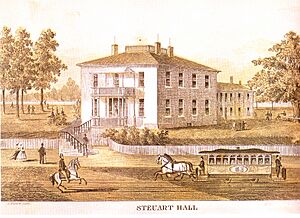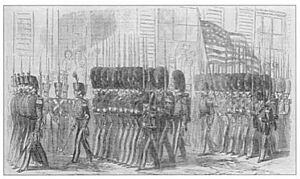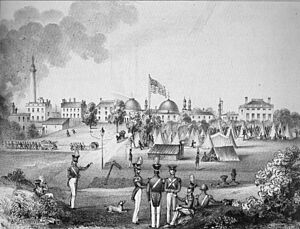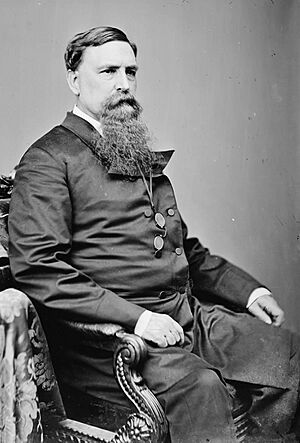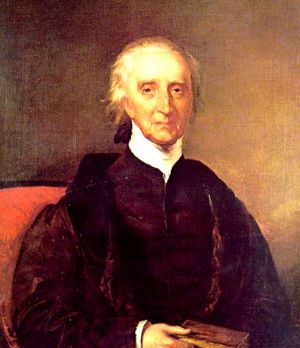George H. Steuart (militia general) facts for kids
Quick facts for kids
George Hume Steuart
|
|
|---|---|
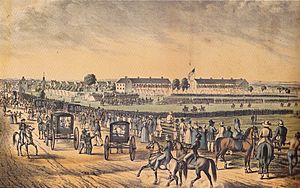
Major General George H. Steuart reviews the Maryland Militia at Camp Frederick, 1843
|
|
| Born | November 1, 1790 Anne Arundel County, Maryland |
| Died | October 21, 1867 (aged 76) Baltimore, Maryland |
| Place of burial | |
| Allegiance | |
| Service/ |
|
| Years of service | 1814-1861 |
| Rank | |
| Commands held | 5th Maryland Regiment, Maryland Militia |
| Battles/wars | War of 1812 |
| Relations | George H. Steuart (grandfather) George H. Steuart (son) William Steuart (uncle) Richard Sprigg Steuart (brother) |
| Other work | planter, politician, lawyer |
George Hume Steuart (1790–1867) was an American general. He fought in the War of 1812. Later, he joined the Confederate States of America during the Civil War.
His military journey started in 1814. He was a captain and led Maryland volunteers. He fought in the Battle of Bladensburg and the Battle of North Point. He was wounded in the Battle of North Point. After the war, he became a major general. He commanded the First Light Division, a part of the Maryland Militia.
In 1859, Steuart led militia during John Brown's raid on Harpers Ferry. As the Civil War neared, he tried to get Maryland to leave the Union. This effort was not successful. In 1861, at 71, he joined the Confederacy. He was considered too old for active fighting. However, he rode with General Lee's army. He was even captured at the First Battle of Manassas.
People sometimes confuse him with his oldest son, Brigadier General George H. Steuart. His son also fought for the Confederacy. The younger Steuart surrendered with General Robert E. Lee in 1865. George Hume Steuart died in 1867. His health and money were ruined by his support for the Southern cause.
Contents
Early Life of George Hume Steuart
George Hume Steuart was born in Anne Arundel County, Maryland. His birthday was November 1, 1790. He was the oldest son of Dr. James Steuart and Rebecca Sprigg. His father, James Steuart, was a doctor. He served in the Revolutionary War.
Young Steuart grew up in two places. One was Sparrow's Point, his family's farm near the Chesapeake Bay. The other was Maryland Square, a large home in West Baltimore. He later went to and graduated from Princeton University. George also had a younger brother, Richard Sprigg Steuart. Richard became a doctor and helped treat mental illness.
Fighting in the War of 1812

When the War of 1812 began, Steuart was a captain. He formed a group of Maryland volunteers. They were called the Washington Blues. This group was part of the 5th Maryland Regiment.
They fought in the Battle of Bladensburg on August 24, 1814. American forces, including Steuart's regiment, were defeated by the British. The 5th Regiment tried to fight hard. But they were surrounded and had to retreat. After this battle, the British burned parts of Washington, D.C.
Steuart's regiment fought better at the Battle of North Point. This battle was on September 12, 1814. The militia held their ground for about an hour. Then they retreated while still fighting. Steuart was wounded during this battle. Some regiments ran away, but the 5th and 27th Regiments stood firm. They caused many injuries to the British.
Corporal John McHenry of the 5th Regiment wrote about the battle. He said his regiment fought very well. He believed they were the last to leave the battlefield. The British lost many soldiers, including their commander. Because of their losses, the British could not take Baltimore. This battle was a turning point in the war.
After the War: A Public Servant
Steuart quickly became a lieutenant-colonel in the 5th Regiment. After the war, he became a lawyer. He was listed as an Attorney-at-Law in Baltimore in 1816.
He served in the Maryland House of Delegates for Baltimore. He was there in 1827 and 1828. In 1835, he ran for Congress but did not win. A painter named Philip Tilyard painted his portrait around 1827 or 1828.
Leading the Militia
In 1833, several Baltimore regiments formed a brigade. Steuart was promoted to brigadier general. From 1841 to 1861, he led the First Light Division, Maryland Volunteers. This was the Maryland Volunteer Militia. He was the Commander-in-Chief of the Maryland Volunteers until the Civil War.
In 1843, Steuart reviewed his troops. He was joined by the Governor of Pennsylvania. Many people watched this event. It was remembered in a picture published that year.
In 1844, the Boston City Greys visited Baltimore. They marched with Steuart's companies. Steuart hosted a party for them at his home, Maryland Square. This event was widely covered in the news.
Steuart also knew Dorothea Dix, a social reformer. She visited him at his country home, Sparrow's Point. Another guest was Fredrika Bremer, a Swedish activist. Dix worked to improve care for the mentally ill. Steuart's brother, Richard Sprigg Steuart, also worked on this issue. The writer Washington Irving was also a frequent guest at Maryland Square.
Keeping Order in Elections
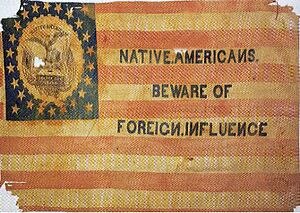
In the mid-1850s, elections in Baltimore were often violent. This was due to the Know Nothing party. In 1856, the mayor asked Steuart to prepare his militia. This was to keep order during the mayoral elections. Steuart ordered his men to be ready. However, the mayor later changed his mind. He feared more violence.
On election day, violence broke out. People were killed and wounded. Artillery was even used in one area. The Know Nothings won the election. There was much voter fraud.
In 1857, the Governor ordered Steuart's militia to be ready again. He wanted to prevent violence. But Mayor Thomas Swann suggested using special police instead. The Governor agreed. There was less violence that year. But the election results were still affected by force.
Slavery and the Civil War
Steuart's family owned enslaved people. They supported the system of slavery. However, they believed in ending it gradually. They wanted to do this by people choosing to free their enslaved people.
In 1828, Steuart was on the board of the Maryland State Colonization Society. This group wanted to help Black Americans move to African countries like Liberia. They believed this would help end slavery.
Around 1842, Steuart inherited land and 125 enslaved people. This made him a large landowner. In 1846, his father died. Steuart then inherited Maryland Square, his family's home.
John Brown's Raid
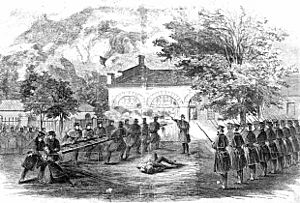
In 1859, Steuart's militia helped stop John Brown's raid on Harpers Ferry. This was an attempt to start a rebellion of enslaved people. Steuart personally led six companies of militia. People cheered them as they left Baltimore. After this event, militias in the South grew. Southerners feared slave rebellions.
In 1860, Steuart wrote a letter. He supported the Fugitive Slave Acts. He also agreed with the Supreme Court's decision in the Dred Scott v. Sandford case. This decision upheld slavery. He also criticized the election of Abraham Lincoln. Lincoln was against slavery.
In 1861, as war got closer, Steuart set up a family trust. This was to care for his large family. The money came from his estates.
The Civil War Begins

By April 1861, war seemed certain. On April 16, Steuart's oldest son, George H. Steuart, left the U.S. Army. He joined the Confederacy. On April 19, there were riots in Baltimore. People who supported the South attacked Union troops. These were some of the first casualties of the Civil War.
Steuart ordered his militia to gather. He wanted them to stop the Union soldiers. Steuart strongly supported the Confederacy. However, the Governor of Maryland refused to call out the militia. He knew public opinion in Baltimore was divided.
Steuart and his son tried hard to convince Maryland to leave the Union. They wanted to use the militia to stop Union soldiers from occupying the state. But their efforts failed. On April 29, the Maryland Legislature voted against leaving the Union. Union soldiers quickly occupied the state.
Leaving Maryland
The situation remained uncertain. On May 13, 1861, Union troops took control of Maryland. This prevented any further moves to leave the Union. By late summer, Maryland was firmly controlled by Union soldiers.
Confederate supporters were arrested. General Steuart fled to Charlottesville, Virginia. Much of his family's property was taken by the U.S. government. Maryland Square was seized by the Union Army. It was renamed Camp Andrew. Union troops stayed in Steuart's mansion. Jarvis Hospital was built on the estate grounds for wounded soldiers.
Steuart was 71 years old. He was considered too old for active service. But he followed the Confederate army. He was near several battles, including Gettysburg. He was even captured at the First Battle of Manassas. Luckily, he was released when they found out he was not a serving officer.
The High Cost of War
Steuart is often confused with his oldest son, Brigadier General George H. Steuart. The son quickly rose in the Confederate army. He fought in many battles, including Cross Keys and Gettysburg. He was wounded and captured. He eventually surrendered with General Lee. People in Baltimore called them "The Old General" and "The Young General."
Steuart's third son, Lieutenant William James Steuart, also fought for the Confederacy. He was badly wounded in the hip. He died in a hospital in Richmond, Virginia, in 1864. A friend wrote to General Steuart about his son's death. He expressed deep sympathy for Steuart's loss.
Steuart's brother, Richard Sprigg Steuart, stayed in Maryland. He openly supported the Confederacy. This meant he had to hide from federal authorities. He lived in fear of being captured.
General Steuart wrote letters to a friend during the war. In these letters, he talked about his sadness over the state of the country.
After the War
Steuart's strong support for the "Lost Cause" hurt him and his family. Maryland Square was returned to him after the war. But neither he nor his children lived there again. Jarvis Hospital closed in 1865. Its buildings were sold off in 1866.
After the war, Steuart traveled to Europe. He returned to Maryland in 1867. He died on October 21, 1867, at age 77. He is buried at Greenmount Cemetery in Maryland. His wife, oldest son, and other family members are also buried there.
Family Life

Steuart married Ann-Jane Edmondson in Baltimore on May 3, 1836. They had 10 children:
- George H. Steuart (1828–1903), a Confederate general.
- Isaac Edmondson Steuart (1830–1891). He suffered from mental illness.
- Lieutenant William James Steuart (1832–1864), killed in 1864.
- Thomas Edmondson Steuart (1834–1866)
- Dr James Henry Steuart (1835–1892)
- Mary Elizabeth Steuart (1837–1840)
- Ann Rebecca Steuart (1839–1865)
- Charles David Steuart (1841–1921). He also suffered from mental illness.
- Margaret Sophia Steuart (1843–1860)
- Henrietta Elizabeth Steuart (1846–1867)
Legacy
There is no monument to Steuart in Maryland. This is because Maryland stayed loyal to the Union. Maryland Square was torn down in 1884. Little remains of his mansion or Jarvis Hospital. However, in 1919, a hospital was opened near the old Jarvis Hospital site. This hospital, now called Grace Medical Center, is still important today. The area is still known as Steuart Hill.


